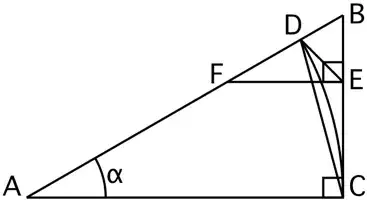We do a computation similar to the one by robjohn. Let $\alpha=2\theta$. By angle-chasing, we can express all the angles in the picture in terms of $\theta$.
Since $\triangle ACD$ is isosceles, $CD=2\sin\theta$. Now we compute $DE$ by using the Sine Law. Note that $\angle CED=\pi-3\theta$ and $\angle DCE=\theta$. Thus
$$\frac{DE}{\sin\theta}=\frac{CD}{\sin(\pi-3\theta)}=\frac{CD}{\sin 3\theta},$$
and therefore
$$DE=\frac{2\sin^2\theta}{\sin 3\theta}.$$
Now use the Sine Law on $\triangle DEF$. We get
$$\frac{EF}{\sin(\pi/2+\theta)}=\frac{DE}{\sin 2\theta}.$$
Since $\sin(\pi/2+\theta)=\cos\theta$, we get
$$EF=\frac{2\sin^2\theta\cos\theta}{\sin 2\theta\sin 3\theta}.$$
Using the identity $\sin 3\theta=3\sin\theta-4\sin^3\theta$, we find the very simple result
$$EF=\frac{1}{3-4\sin^2\theta},$$
and therefore the limit is $1/3$.

